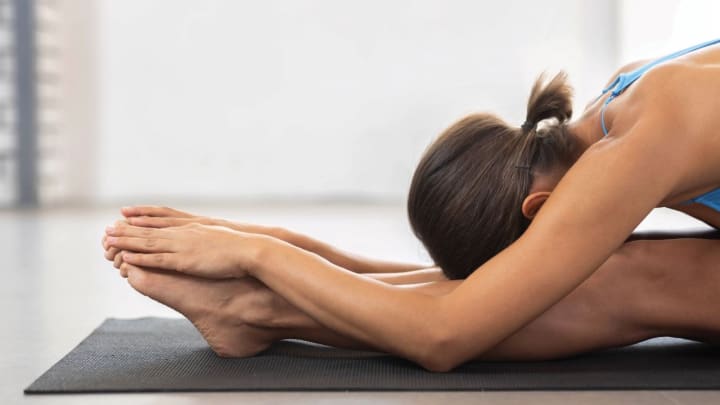A Comprehensive Review of Hyperbolic Stretching
Transform Your Flexibility and Strength

Flexibility, often overlooked in traditional fitness routines, plays a crucial role in enhancing athletic performance, preventing injuries, and promoting overall well-being.
In recent years, various stretching programs have emerged promising remarkable gains in flexibility and strength. One such program that has garnered attention is Hyperbolic Stretching.
Our comprehensive review of Hyperbolic Stretching, is based on multiple sources and reviews, aiming to provide an in-depth understanding of its principles, effectiveness, and suitability for different individuals.
Explore Your Flexibility Potential Today: Discover how Hyperbolic Stretching can transform your flexibility and athletic performance. Click here.
Understanding Hyperbolic Stretching
Overview and Benefits
Hyperbolic Stretching is an online program designed to improve flexibility and strength through a structured 30-day regimen.
Inspired by ancient Asian stretching methods and grounded in modern scientific principles, this program targets key muscle groups like the pelvic floor, core, and back.
The primary aim is to enhance range of motion, core strength, and overall athletic performance.
The program advocates for short, daily routines, approximately 8 minutes a day, making it accessible for individuals with busy schedules.
It combines stretching exercises with bodyweight resistance movements akin to yoga, promoting not only flexibility but also muscular endurance and balance.
The emphasis on minimal equipment and the promise of results within four weeks, backed by a money-back guarantee, positions Hyperbolic Stretching as an attractive option for those looking to enhance their physical capabilities holistically.

Scrutiny and Validation
Despite its promising claims, Hyperbolic Stretching faces scrutiny regarding its scientific validity and accreditation.
Reviews highlight the program’s bold assertions contrasted against a lack of recognised endorsements or detailed scientific studies supporting its efficacy over other stretching methods.
This prompts a cautious approach, suggesting that while the program may benefit those already familiar with dynamic stretching, its broader effectiveness remains subject to personal fitness levels and individual experiences.
In-depth Analysis
A deeper examination reveals Hyperbolic Stretching’s foundation in proprioceptive neuromuscular facilitation (PNF) stretching, a well-researched technique known to improve muscle flexibility and range of motion.
Advocates of the program, such as its creator Alex Larsson, emphasise the transformative potential of PNF stretching in rehabilitation and athletic training.
Scientific literature supports PNF’s effectiveness in enhancing hamstring flexibility and joint mobility, suggesting plausible benefits for participants seeking to advance their flexibility goals systematically.
User Experience and Practical Application
Individual testimonials and user experiences provide valuable insights into the practical application of Hyperbolic Stretching.
Users report varied outcomes, with some attesting to noticeable improvements in flexibility and reduced muscular tension, while others express reservations about its intensity and suitability for beginners or those recovering from injuries.
The program’s structured approach, divided into stages targeting warm-up, split testing, and maintenance routines, underscores its commitment to guiding participants through a progressive journey towards enhanced flexibility and core strength.
Transform Your Strength and Flexibility: Harness the power of Hyperbolic Stretching to reach new fitness heights. Click here.

Scientific Backing and Practical Benefits
The Science Behind Hyperbolic Stretching
Hyperbolic Stretching integrates scientific principles with ancient stretching techniques to optimise flexibility and muscular endurance effectively.
Central to its methodology is the use of PNF stretching, which involves alternating muscle contraction and relaxation to deepen stretches and enhance muscle elasticity.
This approach is supported by research demonstrating PNF’s efficacy in improving range of motion and reducing muscle stiffness, particularly beneficial for athletes and individuals engaged in physical rehabilitation.
Benefits and Outcomes
The benefits attributed to Hyperbolic Stretching encompass improved flexibility, increased athletic performance, enhanced core strength, and better posture.
Regular practice of the program’s routines not only promotes physical flexibility but also contributes to mental well-being by reducing stress and improving body awareness.
Users attest to feeling more energised and resilient, attributing these benefits to the program’s holistic approach to fitness through structured stretching and core strengthening exercises.
Considerations and Recommendations
Who Should Try Hyperbolic Stretching?
Hyperbolic Stretching is best suited for individuals already engaged in physical activities like yoga, running, weightlifting, or dance.
Its focus on dynamic stretching and core activation makes it particularly appealing to athletes and fitness enthusiasts seeking to enhance their performance through improved flexibility and muscular endurance.
Beginners and individuals recovering from injuries should approach the program cautiously, consulting healthcare professionals to determine suitability and mitigate risks.

Achieve Remarkable Flexibility in Just 30 Days: Join thousands who've transformed their flexibility with our proven program - Here.
Summary
Hyperbolic Stretching presents a compelling option for individuals looking to enhance their flexibility, core strength, and overall physical performance.
Rooted in a blend of ancient wisdom and modern scientific research, the program offers a structured approach to achieving significant gains in range of motion and muscular flexibility within a relatively short timeframe.
While its claims may invite scrutiny regarding scientific validation and universal applicability, user testimonials and emerging research on PNF stretching support its potential benefits for enhancing athletic capabilities and promoting holistic wellness.
As with any fitness program, success with Hyperbolic Stretching hinges on consistency, proper technique, and alignment with individual fitness goals.
By integrating these principles into a balanced fitness regimen, participants can unlock their full potential in flexibility and physical resilience, paving the way for a healthier and more active lifestyle.
While Hyperbolic Stretching focuses on dynamic flexibility and muscle strengthening through targeted stretching routines, another effective method for enhancing flexibility and overall physical well-being is Pilates.
Pilates offers a holistic approach that not only improves flexibility but also focuses on core strength, posture, and mind-body connection.
If you're interested in exploring a structured yet adaptable exercise system that complements your flexibility goals, consider learning more about Pilates.
REFERENCES
The Acute Effects of Static Stretching on Muscle Strength and Power Output by Sarah M. Marek, Journal of Athletic Training, 2005.
Schieppati M, Nardone A. Medium-latency stretch reflexes of foot and leg muscles analysed by cooling the lower limb in standing humans. J Physiol. 1997;503(Pt 3):691–8.
Liddell EG, Sherrington CS. Reflexes in response to stretch (Myotatic reflexes) Proc Roy Soc. 1924;96:212–42.
Denny-Brown DE, Liddell EG. The stretch reflex as a spinal process. J Physiol. 1927;63:144–50.
Marsden CD, Merton PA, Morton HB. Is the human stretch reflex cortical rather than spinal? Lancet. 1973;1:759–61.
Granit R. The Basis of Motor Control. London: Academic Press; 1970.
Marsden CD, Merton PA, Morton HB. Stretch reflex and servo action in a variety of human muscles. J Physiol. 1976;259:531–60.
Palmer E, Ashby P. Evidence that a long latency stretch reflex in humans is transcortical. J Physiol. 1992;449:429–40.
Matthews PB. The human stretch reflex and the motor cortex. Trends Neurosci. 1991;14:87–91.
Capaday C, Forget R, Fraser R, Lamarre Y. Evidence for a contribution of the motor cortex to the long-latency stretch reflex of the human thumb. J Physiol. 1991;440:243–55.
The stretch reflex and the contributions of C David Marsden, Kalyan B. Bhattacharyya Ann Indian Acad Neurol. 2017 Jan-Mar; 20(1): 1–4.
Functional relationships between myotatic reflex arcs of the lower limb in man: Investigation by exc. curves. U.S. National Library of Medicine, P. J. Delwaide, 1976.
A pilot randomized trial of conventional versus advanced pelvic floor exercises: a study protocol, D.S. Mina, 2015.
A Factor in Nitric Oxide, Biljana Musicki, PMC 2011.
Dynamic stretching program
PNF stretching program (Proprioceptive Neuromuscular Facilitation)
Flexibility training regimen
Advanced stretching techniques
Comprehensive flexibility program
About the Creator
Enjoyed the story? Support the Creator.
Subscribe for free to receive all their stories in your feed. You could also pledge your support or give them a one-off tip, letting them know you appreciate their work.





Comments
There are no comments for this story
Be the first to respond and start the conversation.